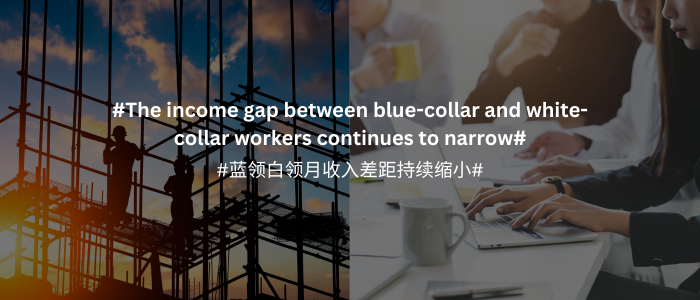Traditionally, white-collar jobs, often associated with higher education and income potential, have been perceived as more prestigious and socially esteemed compared to blue-collar occupations. However, due to various factors, such as financial pressures and the devaluation of higher education, an increasing number of young people in China are opting to leave their office jobs and find happiness in blue-collar occupations, among which “light labor jobs” such as baristas and cashiers have become increasingly popular among Chinese youth.
Download our report on Gen Z consumers

China’s blue-collar growth: a decade of narrowing income gap
According to a report on the employment situation of China’s blue-collar workers released on January 23rd, the working-class workforce in China has reached a scale of over 400 million people. Over the past decade, #the income gap between blue-collar and white-collar workers continues to narrow# (蓝领白领月收入差距持续缩小), which became a heated discussion on Weibo and garnered over 4.6 million views in the 3rd week of January. The average monthly income of blue-collar workers has significantly increased, rising from RMB 2,684 in 2012 to RMB 6,043 in 2023, marking a 126% increase. In stark contrast, the average monthly income for white-collar workers is RMB 8,388, an increase of only around 30% from 2012.
Emerging blue-collar occupations in a changing job market
Among these working-class jobs, postpartum caregivers, truck drivers, and food delivery riders ranked the highest in terms of income levels, whereas janitors and security guards are still earning relatively low incomes. “The scope of the manual-labor workforce has been largely expanded. Many new blue-collar occupations have emerged due to the rise of industries such as food delivery and express delivery.” A netizen commented.

Implications of the shift in perceptions
Traditional notions of job prestige are shifting, with an increasing number of young people in China choosing blue-collar occupations over white-collar jobs. This change in perception may impact talent acquisition and retention strategies for companies, requiring a reevaluation of how they position and market different types of jobs. Besides, the narrowing income gap between blue-collar and white-collar workers suggests a changing economic landscape, which could have implications for consumer spending patterns, demand for goods and services, and overall market opportunities.
What to know about the income gap
- There is a trend towards “light labor jobs” like baristas and cashiers gaining popularity.
- Over the past decade, the income gap between blue-collar and white-collar workers has narrowed, sparking discussions on Weibo.
- Growth of the blue-collar workforce has occurred by creating new occupations driven by the emergence of industries such as food and express delivery.
- Narrowing the income gap suggests a changing economic landscape with potential implications for consumer behavior and overall market opportunities.





